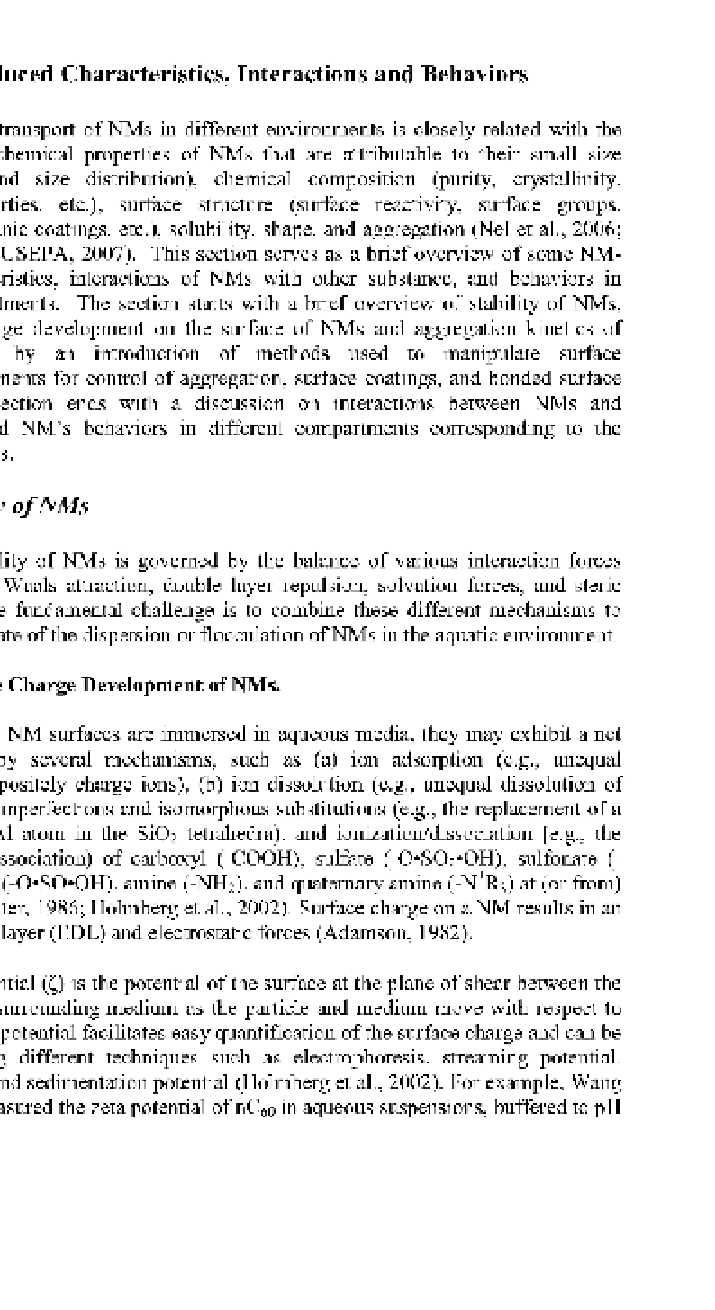Environmental Engineering Reference
In-Depth Information
15.5 NM-Induced Characteristics, Interactions and Behaviors
Fate and transport of NMs in different environments is closely related with the
unusual physicochemical properties of NMs that are attributable to their small size
(surface area and size distribution), chemical composition (purity, crystallinity,
electronic properties, etc.), surface structure (surface reactivity, surface groups,
inorganic or organic coatings, etc.), solubility, shape, and aggregation (Nel et al., 2006;
Xia et al., 2006; USEPA, 2007). This section serves as a brief overview of some NM-
induced characteristics, interactions of NMs with other substance, and behaviors in
different compartments. The section starts with a brief overview of stability of NMs,
focusing on charge development on the surface of NMs and aggregation kinetics of
NMs, followed by an introduction of methods used to manipulate surface
chemistry/components for control of aggregation, surface coatings, and bonded surface
The section ends with a discussion on interactions between NMs and
contaminants and NM's behaviors in different compartments corresponding to the
properties of NMs.
75.5.7
Stability of NMs
The stability of NMs is governed by the balance of various interaction forces
such as van der Waals attraction, double layer repulsion, solvation forces, and steric
The fundamental challenge is to combine these different mechanisms to
understand the state of the dispersion or flocculation of NMs in the aquatic environment.
15.5.1.1 Surface Charge Development of NMs.
When the NM surfaces are immersed in aqueous media, they may exhibit a net
surface charge by several mechanisms, such as (a) ion adsorption (e.g., unequal
adsorption of oppositely charge ions), (b) ion dissolution (e.g., unequal dissolution of
ions), (c) lattice imperfections and isomorphous substitutions (e.g., the replacement of a
Si atom by an Al atom in the SiC>2 tetrahedra), and ionization/dissociation [e.g., the
ionization (or dissociation) of carboxyl (-COOH), sulfate (-OSCVOH), sulfonate (-
SO
2
'OH), sulfite (-OSOOH), amine (-NH
2
), and quaternary amine (-N
+
R
3
) at (or from)
the surface] (Hunter, 1986; Holmberg et al., 2002). Surface charge on a NM results in an
electrical double-layer (EDL) and electrostatic forces (Adamson, 1982).
Zeta potential (Q is the potential of the surface at the plane of shear between the
particle and the surrounding medium as the particle and medium move with respect to
each other. Zeta potential facilitates easy quantification of the surface charge and can be
determined using different techniques such as electrophoresis, streaming potential,
electro osmosis and sedimentation potential (Holmberg et al., 2002). For example, Wang
et al. (2008a) measured the zeta potential of nCeo in aqueous suspensions, buffered to pH

Search WWH ::

Custom Search